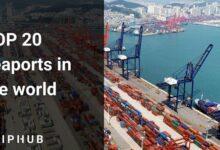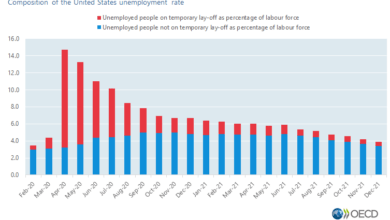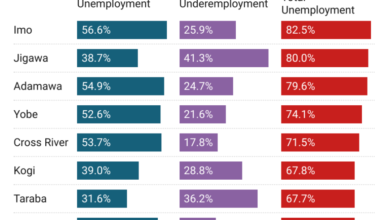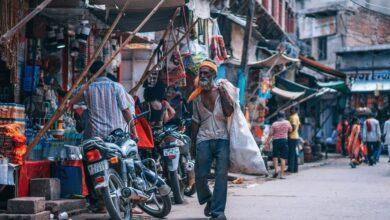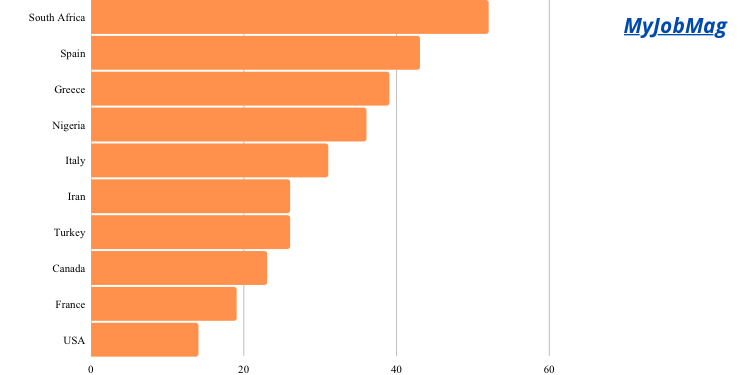
Top 15 Countries with high unemployment rates in Africa
Top 15 Countries with high unemployment rates in Africa – Unemployment remains one of the most persistent economic challenges facing the African continent today. According to the International Labour Organization (ILO), the unemployment rate in Africa was estimated to be around 7.4% in 2022. However, this average masks the wide disparities in unemployment levels across different African countries.
Some countries on the continent have unemployment rates well above the African average. High unemployment rates have far-reaching consequences for the economic, social and political stability of a country. They result in lost economic output, increased poverty and inequality, social tensions and discontent. For the majority of Africa’s unemployed who are youths, limited employment opportunities have fueled irregular migration in search of better prospects abroad.Top 15 Countries with high unemployment rates in Africa
👉 Relocate to Canada Today!
Live, Study and Work in Canada. No Payment is Required! Hurry Now click here to Apply >> Immigrate to CanadaThis article provides a snapshot of the countries with the highest unemployment rates in Africa as of 2023, based on data from Statista. The countries are ranked in descending order, starting with the highest unemployment rates on the continent. For each country, the article provides an overview of the economy, factors causing high unemployment, effects of unemployment, and measures being taken to address the problem where available.
The Top 15 Countries with high unemployment rates in Africa are:
1. South Africa – 29.95%
South Africa has the distinction of having the highest unemployment rate not just in Africa but across the entire world. With unemployment touching 30%, South Africa’s labour market crisis has reached dizzying heights.
Africa’s second-largest economy after Nigeria, South Africa has well-developed financial, infrastructure, energy and transport sectors. However, economic mismanagement and corruption under previous administrations left the country with weak growth, high debt and soaring joblessness. The economy took a further beating from the impact of the COVID-19 pandemic.
Key drivers of South Africa’s high unemployment include an over-reliance on capital-intensive sectors that generate insufficient jobs, skills mismatch between workforce and industry needs, economic stagnation, high inequality and the legacy of apartheid marginalizing the black majority from the job market.
The dire unemployment situation exacerbates South Africa’s extreme inequalities. It fuels poverty and social discontent as evidenced by the sporadic outbreaks of violence and mass looting that made international headlines in 2021. Tackling joblessness has become an urgent priority for the government. Key measures adopted include public works schemes, employment tax subsidies and youth employment programs. But given the gravity and complexity of the problem, much more needs to be done to curb unemployment.
Read Also: 15 Best Home Remedies in Nigeria
2. Djibouti – 27.95%
Djibouti’s economy relies heavily on its strategic location at the southern entrance to the Red Sea. The country leverages its prime geographic position to earn substantial revenues from its transport and logistics facilities that serve neighbouring countries. However, despite its strategic advantages, Djibouti’s unemployment rate stands at a troubling 27.95%.
Some factors behind the high joblessness include skill gaps between graduates and labour market requirements, economic reliance on low labour-intensive sectors, and gaps in labour market regulation.
👉 Relocate to Canada Today!
Live, Study and Work in Canada. No Payment is Required! Hurry Now click here to Apply >> Immigrate to CanadaThe construction, telecommunications and services related to Djibouti’s transport infrastructure are important sectors. But they fail to create sufficient employment opportunities, resulting in high youth unemployment in particular. Joblessness leads to increased poverty and threatens political stability in a small country of just 1. 106 million people.
Djibouti has recognized unemployment as a policy priority. The government aims to address the problem through development plans focused on education and training, strengthening labour market institutions, employment policies targeting youth and women, and programs to support job creation in industries with high growth potential.
3. Eswatini – 24.66%
Formerly Swaziland, Eswatini is one of Africa’s last absolute monarchies. The small, landlocked southern African country suffers from elevated unemployment rates averaging 24.66% of the labour force.
Eswatini has a small economy dependent on subsistence agriculture and based primarily on sugar exports. Underlying the high unemployment are issues like poor economic growth, low workforce skills, high HIV/AIDS prevalence discouraging business investment, rapid population growth outstripping job creation, and over-reliance on the shrinking agricultural sector.
Unemployment disproportionately affects Eswatini’s youth, forcing many to seek work in neighbouring South Africa. The country’s AIDS epidemic aggravates poverty and unemployment by increasing the number of child-headed households and orphans. As a lower middle-income nation, Eswatini faces difficulties in financing programs needed to spur job creation and sustainable economic growth.
Government efforts to address unemployment include vocational training policies, public works initiatives and special funds to support new graduates to start businesses. But the country continues to face monumental challenges in resolving its prolonged unemployment crisis.
4. Congo – 21.57%
The Republic of Congo suffers from high rates of poverty and inequality despite its oil wealth. With over 60% of citizens living below the poverty line, unemployment is a major development challenge for the Central African country.
Congo’s unemployment level stands at 21.57% as of 2023. Reliance on oil results in an undiversified economy with insufficient employment opportunities in non-oil sectors. Significant oil revenues also inflate the exchange rate, undermining the competitiveness and growth of other industries.
Most Congolese are employed in vulnerable informal jobs, while youth unemployment is worryingly high at 15%. Underfunded education fails to provide skills relevant to the labour market. Infrastructure gaps, poor governance, corruption and regional instability further constrain private sector job creation.
Read Also: Top 15 Timber-Producing Countries in Asia
5. Gabon – 21.4%
Gabon is one of Central Africa’s most prosperous countries thanks to its mineral wealth. But the country still grapples with high unemployment estimated at 21.4% in 2023.
As an upper-middle-income country, Gabon’s development challenges are shaped by its dependence on oil. Volatile oil prices lead to boom and bust cycles that disrupt economic planning and job creation. Efforts at economic diversification have achieved limited success. The oil sector employs just 1% of Gabon’s labour force. But it drains resources and labour from other potentially vibrant sectors.
Gabon also faces a severe mismatch between the skills of graduates and the jobs available in the market. This fuels unemployment, especially among youth. Limited infrastructure development constrains growth in non-oil sectors and private sector job creation.
The Gabonese government recognizes the need to reduce dependence on oil to create sustainable employment opportunities. It adopted the Emerging Gabon Strategic Plan in 2012 to expand infrastructure, diversify the economy, promote human capital and facilitate job creation. But reforming Gabon’s oil-centred economy remains a complex challenge requiring sustained, long-term efforts.
6. Botswana – 20.81%
Botswana has achieved remarkable economic progress since independence to become one of Africa’s most stable and prosperous nations. Yet unemployment remains stubbornly high exceeding 20% over the past decade.
Botswana’s economy relies heavily on its rich diamond reserves. But the mining industry employs only 3% of the workforce. Weak private sector development, skills mismatches, infrastructure gaps, uneven income distribution and over-reliance on public sector jobs all contribute to unemployment.
Diamond-led growth has reduced economic diversification. Uncompetitive industries struggle to survive without government support. Low skills base and weak linkages between industry and vocational training produce skill shortages and mismatches. These stifle private-sector employment growth. Although the government is the dominant employer, public sector hiring freezes since 2009 have reduced job opportunities.
Unemployment fuels rising inequality by discouraging income-generating activities for the poor. Joblessness disproportionately affects the youth, women and less educated.
7. Namibia – 20.59%
Namibia faces acute unemployment levels despite being one of Africa’s most stable and best-governed countries. The southwestern African nation currently contends with unemployment of nearly 21%.
Namibia’s economy relies heavily on mining, agriculture and fishing. Insufficient economic diversification constrains employment creation. The mismatch between graduates’ skills and labour market demands results in graduate unemployment four times the national rate. Rural-urban migration increases job competition in urban centres.
High unemployment fuels inequality and poverty. Close to two-thirds of Namibia’s unemployed have been jobless for over a year. The loss of income and opportunity costs impose a heavy burden on individuals, families and the economy.
The government recognizes unemployment’s socio-economic costs. Its policy responses include public works programs, vocational training, and assistance to micro, small and medium enterprises. Addressing skills mismatches through education reforms is another priority. But policy consistency and effectiveness have been a challenge. Fundamentally transforming Namibia’s job market requires diversifying the narrow export-based economy.
8. Libya – 20.52%
Political instability and armed conflict have wrecked Libya’s oil-driven economy since the 2011 revolution. Unemployment tripled in the decade after Gaddafi’s overthrow. The youth unemployment rate exceeds 50% in the war-torn country.
Disruptions to oil production starved government coffers of revenues needed for economic development projects. Insecurity and political divisions deter foreign firms from investing and operating in Libya. Persistent violence also disrupts domestic economic activity and devastates infrastructure.
Libya’s large public sector employed an outsized share of citizens under Gaddafi. But constant violence leaves the state unable to maintain salary and subsidy payments, forcing layoffs and hiring freezes. The weak, oil-dependent private sector offers few alternative job opportunities. Locals also face competition from irregular migrant workers willing to accept lower wages.
Rebuilding Libya’s shattered economy and creating jobs for restless youth is critical for lasting peace and stability. Fundamental political and security reforms are required before the monumental challenge of job creation can even begin.
Read Also: Top 15 Countries with Extensive Metal Resources
9. Somalia – 20.43%
Somalia has endured over two decades of civil war, political instability and devastating famine. After emerging as a failed state, Somalia now seeks to rebuild its shattered economy and create employment opportunities for its fast-growing population. But the Horn of Africa nation still contends with unemployment rates exceeding 20%.
Years of conflict destroyed Somalia’s formal economy and limited livelihood opportunities. Livestock, agriculture and fisheries currently employ most Somalis in largely informal, subsistence activities. Private enterprises face major constraints from inadequate infrastructure, lack of access to finance, weak regulation and insecurity.
Unemployment leaves young Somalis vulnerable to recruitment by armed groups like Al-Shabaab. Remittances from the Somali diaspora play a vital role in household incomes. But sustainable solutions require rebuilding Somalia’s capacity for economic governance and job creation.
10. Sudan – 18.48%
Sudan contended with extreme political instability and economic crises for decades under the authoritarian rule of Omar al-Bashir. His overthrow in 2019 came as a relief, but Sudan’s challenges remain daunting as it navigates the transition to civilian rule.
Key among these challenges is reviving Sudan’s depressed economy and creating employment. Unemployment averaged over 18% from 2014 to 2020 as the economy stagnated. Underemployment is even higher at nearly 25%.
Conflict, secession of oil-rich South Sudan, economic mismanagement and crippling US sanctions eroded productive sectors able to create jobs. Agriculture employs around 57% of Sudanese but suffers from low productivity, poor infrastructure and climatic uncertainties. Meanwhile, the industrial and services sectors struggle to grow under difficult business conditions.
11. Lesotho – 17.88%
Embedded within South Africa, the small mountainous country of Lesotho suffers from chronic unemployment and poverty. Joblessness averages close to 18% due to anaemic growth and limited economic diversification.
The textile industry is Lesotho’s largest employer after the government but has experienced major retrenchments. Agriculture provides livelihoods for 70% of the population but remains underdeveloped and vulnerable to weather shocks. Rapid urbanization outpaces job creation in urban areas. Emigration to South Africa reduces unemployment but exacerbates skill shortages.
12. Tunisia – 16.14%
The birthplace of the Arab Spring, Tunisia is viewed as the sole success story of the 2011 uprisings. But continued economic struggles threaten the country’s democratic transition. With about 16% of its labour force unemployed, Tunisia contends with one of the highest unemployment rates regionally and in Africa.JAMB portal
The key factors behind Tunisia’s high unemployment are lack lustre economic growth, a massive informal sector exceeding 50% of the workforce, skills mismatches between graduates and employers, and regional disparities in development.Good morning My Love Message
Unemployment among university graduates reaches alarming levels exceeding 30%. Joblessness is also disproportionately concentrated among women and youth. The resulting poverty and exclusion fuel social discontent.
Read Also: Top 15 Countries with Extensive Metal Resources
13. Sao Tome and Principe – 15.52%
The tiny island nation of Sao Tome and Principe enjoys political stability and middle-income status unusual among oil-producing African states. Still, decent job opportunities remain scarce in the country where unemployment averaged around 15.5% from 2010 to 2020.
Heavily reliant on cocoa exports, Sao Tome features high underemployment in agriculture. The manufacturing and services sectors are minuscule. Infrastructure gaps, limited skilled workforce, weak institutions and business regulations constrain diversification and private sector development.
High oil revenues sharply reduced poverty levels, but prudent policies will be critical to ensure economic growth remains inclusive. The government has emphasized reforms to improve the business environment, upgrade workforce skills, build infrastructure and diversify the economy. But reducing unemployment sustainably will be a long-term endeavour for Sao Tome and Principe.Information guide Nigeria
14. Cabo Verde – 13.51%
The small island archipelago nation of Cabo Verde has an open, service-based economy and enjoys political stability and good governance. Yet the twin island country still wrestles with high unemployment levels averaging 13.51% from 2010 to 2020.
Cabo Verde has limited natural resources and suffers from frequent droughts. Most of the workforce engages in low-productivity, informal agricultural and fishing activities. The economy relies heavily on tourism, remittances and foreign aid, leaving it susceptible to external shocks. Weak private sector limits job creation.NYSC Portal
High unemployment disproportionately affects the significant youth population, over half of whom lack jobs. Ongoing efforts by the government to strengthen economic management, attract FDI, expand tourism, develop the private sector and upgrade education aim to open up more quality employment opportunities. But structural vulnerabilities will continue to constrain Cabo Verde’s labour market.
15. Rwanda – 12.71%
Rwanda has made tremendous strides in rebuilding its economy and institutions after the devastating 1994 genocide. Thanks to strong governance, growth has averaged over 7% for two decades. However, unemployment remains moderately high exceeding 12%.Romantic love message
The small, landlocked country has one of the highest population densities in Africa, generating intense competition for jobs. Priority sectors like agriculture and services have low productivity and wages. Women face barriers entering the workforce. Demographic pressures require rapid job creation, which the formal private sector has struggled to deliver.
Expanding access to skills training and education is critical for Rwanda’s development. The government also actively formulates policies, provides incentives and builds infrastructure to accelerate job creation in priority sectors. But as a poor, aid-dependent country, Rwanda faces major constraints in transforming its labour market and reducing unemployment to desired levels.
Read Also: Top 15 Local NGOs in Nigeria
Conclusion:
Africa’s unemployment crisis poses an enormous challenge to the continent’s sustainable development prospects. Several countries grapple with extremely high joblessness exceeding 20% of the working-age population. Even economies regarded as success stories struggle with unemployment in the double digits.
Key factors fueling Africa’s high unemployment rates include sluggish growth, reliance on capital-intensive extractives sectors, skills mismatches, infrastructure deficits, corruption and misgovernance, and vulnerability to internal and external economic shocks.
Unemployment disproportionately affects African youth, excluding them from economic opportunities and fuelling instability. Left unaddressed, joblessness will continue exacting heavy economic, social and political costs across Africa.
Tackling unemployment requires comprehensive, context-specific strategies focused on accelerating inclusive growth, diversifying economies, upgrading workforce skills, improving infrastructure, strengthening governance and promoting private sector development. African governments recognize the gravity of the continent’s unemployment crisis. But the effectiveness of their policy responses varies significantly.
Sustainably reducing unemployment to acceptable levels will require major long-term investments and reforms to modernize Africa’s economies. With its fast-growing, youthful population, Africa has tremendous potential to become the world’s next major hub for job creation. But realizing that potential will depend on pursuing sound policies and catalyzing structural economic transformation across the continent.
Check JAMB RESULT
Check and Confirm: How much is Dollar to Naira

